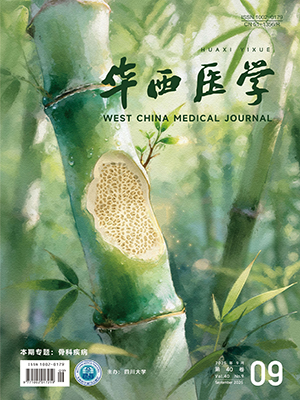| 1. |
Kameda T, Imamura T, Nakashima K. Epigenetic regulation of neural stem cell differentiation towards spinal cord regeneration. Cell Tissue Res, 2018, 371(1): 189-199.
|
| 2. |
Lopez-Verrilli MA, Picou F, Court FA. Schwann cell-derived exosomes enhance axonal regeneration in the peripheral nervous system. Glia, 2013, 61(11): 1795-1806.
|
| 3. |
Pernet V, Schwab ME. The role of Nogo-A in axonal plasticity, regrowth and repair. Cell Tissue Res, 2012, 349(1): 97-104.
|
| 4. |
Yang Z, Duan H, Mo L, et al. The effect of the dosage of NT-3/chitosan carriers on the proliferation and differentiation of neural stem cells. Biomaterials, 2010, 31(18): 4846-4854.
|
| 5. |
López-Leal R, Díaz-Viraqué F, Catalán RJ, et al. Schwann cell reprogramming into repair cells increases miRNA-21 expression in exosomes promoting axonal growth. J Cell Sci, 2020, 133(12): jcs239004.
|
| 6. |
汪雷, 宋跃明, 刘立岷, 等. NEP1-40 基因修饰的神经干细胞移植对脊髓损伤大鼠行为学恢复的影响. 华西医学, 2014, 29(11): 2006-2011.
|
| 7. |
汪雷, 宋跃明, 袁海峰, 等. NEP1-40 基因修饰对神经干细胞移植后存活和分化的影响. 中国修复重建外科杂志, 2013, 27(11): 1368-1374.
|
| 8. |
王林楠, 汪雷, 宋跃明, 等. 慢病毒介导 NEP1-40 及 NT-3 双基因转染神经干细胞的实验研究. 中国修复重建外科杂志, 2018, 32(4): 420-427.
|
| 9. |
Wang D, Zhang J. Effects of hypothermia combined with neural stem cell transplantation on recovery of neurological function in rats with spinal cord injury. Mol Med Rep, 2015, 11(3): 1759-1767.
|
| 10. |
Kabatas S, Teng YD. Potential roles of the neural stem cell in the restoration of the injured spinal cord: review of the literature. Turk Neurosurg, 2010, 20(2): 103-110.
|
| 11. |
Wu MF, Zhang SQ, Gu R, et al. Transplantation of erythropoietin gene-modified neural stem cells improves the repair of injured spinal cord. Neural Regen Res, 2015, 10(9): 1483-1490.
|
| 12. |
GrandPré T, Li S, Strittmatter SM. Nogo-66 receptor antagonist peptide promotes axonal regeneration. Nature, 2002, 417(6888): 547-551.
|
| 13. |
Cao Y, Shumsky JS, Sabol MA, et al. Nogo-66 receptor antagonist peptide (NEP1-40) administration promotes functional recovery and axonal growth after lateral funiculus injury in the adult rat. Neurorehabil Neural Repair, 2008, 22(3): 262-278.
|
| 14. |
张姣飞, 林健华, 王酉, 等. 人羊膜上皮干细胞来源的外泌体促进小鼠神经干细胞向神经元方向分化. 中国细胞生物学学报, 2018, 40(8): 1343-1349.
|
| 15. |
Zhang YZ, Liu F, Song CG, et al. Exosomes derived from human umbilical vein endothelial cells promote neural stem cell expansion while maintain their stemness in culture. Biochem Biophys Res Commun, 2018, 495(1): 892-898.
|
| 16. |
周少婷, 赵静. 内皮细胞外泌体对神经干细胞活力的影响研究. 老年医学与保健, 2018, 24(4): 420-422, 430.
|
| 17. |
Chen G, Hu YR, Wan H, et al. Functional recovery following traumatic spinal cord injury mediated by a unique polymer scaffold seeded with neural stem cells and Schwann cells. Chin Med J (Engl), 2010, 123(17): 2424-2431.
|
| 18. |
Niapour A, Karamali F, Nemati S, et al. Cotransplantation of human embryonic stem cell-derived neural progenitors and Schwann cells in a rat spinal cord contusion injury model elicits a distinct neurogenesis and functional recovery. Cell Transplant, 2012, 21(5): 827-843.
|
| 19. |
Assinck P, Duncan GJ, Hilton BJ, et al. Cell transplantation therapy for spinal cord injury. Nat Neurosci, 2017, 20(5): 637-647.
|
| 20. |
Ching RC, Wiberg M, Kingham PJ. Schwann cell-like differentiated adipose stem cells promote neurite outgrowth via secreted exosomes and RNA transfer. Stem Cell Res Ther, 2018, 9(1): 266.
|
| 21. |
Kingham PJ, Kalbermatten DF, Mahay D, et al. Adipose-derived stem cells differentiate into a Schwann cell phenotype and promote neurite outgrowth in vitro. Exp Neurol, 2007, 207(2): 267-274.
|
| 22. |
Pegtel DM, Gould SJ. Exosomes. Annu Rev Biochem, 2019, 88: 487-514.
|
| 23. |
Wei Z, Fan B, Ding H, et al. Proteomics analysis of Schwann cell-derived exosomes: a novel therapeutic strategy for central nervous system injury. Mol Cell Biochem, 2019, 457(1/2): 51-59.
|
| 24. |
Lopez-Leal R, Court FA. Schwann cell exosomes mediate neuron-glia communication and enhance axonal regeneration. Cell Mol Neurobiol, 2016, 36(3): 429-436.
|
| 25. |
Wang JM, Zeng YS, Wu JL, et al. Cograft of neural stem cells and Schwann cells overexpressing TrkC and neurotrophin-3 respectively after rat spinal cord transection. Biomaterials, 2011, 32(30): 7454-7468.
|
| 26. |
Guo JS, Zeng YS, Li HB, et al. Cotransplant of neural stem cells and NT-3 gene modified Schwann cells promote the recovery of transected spinal cord injury. Spinal Cord, 2007, 45(1): 15-24.
|
| 27. |
Jafari D, Shajari S, Jafari R, et al. Designer exosomes: a new platform for biotechnology therapeutics. BioDrugs, 2020, 34(5): 567-586.
|
| 28. |
Kadoya K, Tsukada S, Lu P, et al. Combined intrinsic and extrinsic neuronal mechanisms facilitate bridging axonal regeneration one year after spinal cord injury. Neuron, 2009, 64(2): 165-172.
|
| 29. |
Okada S, Hara M, Kobayakawa K, et al. Astrocyte reactivity and astrogliosis after spinal cord injury. Neurosci Res, 2018, 126: 39-43.
|




